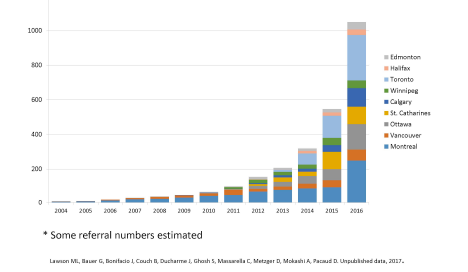Today, from the cancelled archives, I give you: banned writing.
This is something I wrote back in 2019 for a publication in Canada. A lot has changed since then, and not for the better, but I think this piece of writing is still relevant. I chose “gender” as my topic for this particular piece. Part of the reasoning it wasn’t published is because “this piece doesn’t make a clear, well-researched argument…there is not enough clarity”. Ah well, you win some, you lose some.
Good luck reading my confusing writing from 2019.
What if Gender is a Bad Idea
Trans Youth CAN! Is a multi-disciplinary research project that conducts research on short- and long-term experiences and outcomes for young people who identify as transgender and receive clinical care. According to the Trans Youth CAN! research team, children’s clinics across the country have seen a sharp increase in the number of teenagers who identify as transgender and who seek medical assistance and support.
This infographic was created by Greta Bauer and Margaret Lawson for Trans Youth CAN! and is available at http://transyouthcan.ca/results/
The increase in transgender identification among young people and provision of medical and other assistance to these young people is increasing, this is fact. One of the worrisome facets of this phenomenon is that this trend is occurring at the same time as discussions that question or critique transgender ideology, subsequent medical and social interventions, and the encoding of “gender identity” into law and policy is being actively suppressed.
Yet, gender, sex and their meanings impact everyone. With an increase in young people (and others) identifying as transgender and receiving medical treatment that validates an individual’s “gender identity”, publicly discussing and debating this concept - what it means, how it impacts our culture, and what to do about it - is more important than ever.
Instead, municipal, provincial, and federal governments in Canada and elsewhere quickly adopted a perspective that understands “gender identity” as “…each person’s internal and individual experience of gender. It is their sense of being a woman, a man, both, neither, or anywhere along the gender spectrum” (Department of Justice Canada); as “…an internal and deeply felt sense of being a man or woman, both or neither” (Status of Women Canada)1; and “…the gender that a person internally feels” (Statistics Canada). In this definition, gender identity is an internal experience of gender; an internal sense of being a “woman” or “man”, neither, or some combination of both. This is the dominant and considered the only acceptable way to approach transgender issues in Canada today. However, to adopt law and policy and recommend medical interventions for young people and others who are not comfortable with their bodies on the basis of an unspecified internal feeling, sense, or experience without creating an environment that allows for other theories of gender and what to do about these issues, is very troublesome.
Much more discussion and debate is needed around “gender” and subsequently, “gender identity”: What is it? What does it mean to have an internal sense of being a woman? Of being a man? What are potential benefits and disadvantages to embedding undefined feelings into law and policy? Having open, honest, and respectful discussions about “gender” is important to fully inform and responsibly advance law, policy, and medical and social understandings, treatments and interventions. Being exposed to, researching, and critically examining different definitions of “gender” is an important part of this process.
An alternate and feminist definition of gender is the arbitrary set of limitations and expectations (femininity/masculinity) placed on us because of our sex as female or male. This is how I, and many other feminists, think about “gender”. According to this theory, constructed by radical feminists, “gender” is essentially arbitrary rules that dictate “proper” appearance and behaviour of women and men. For example, women are pressured (consciously or unconsciously) to wear uncomfortable and restrictive clothing such as underwire bras and high heels in order to make ourselves “attractive” to men so that we feel good about ourselves. Men do not have the same pressure (conscious or unconscious) to hinder their movement and comfort in order to make themselves attractive and to feel good about themselves. Here we can clearly see how gender contributes to the oppression of women by men. According to this feminist theory, gender is not a spectrum, but a hierarchy, and is a set of ideas that should be abolished instead of further embedded into our culture. Putting forth a definition of gender as a social construction and sex as a biological reality is today considered transphobic and hateful and is punished, in academia and elsewhere, sometimes with no-platforming, threats (see www.terfisaslur.com) and sometimes with physical attacks (for example, the beating of then 60-year-old Maria MacLachlan by trans activists).
What is “gender”? How does it shape and impact our culture? What should we do about it? These matters are not settled, although they’re presented as if they are. Defining and acting on “gender identity” as fact instead of theory and actively suppressing any question or critique of “gender identity” and subsequent treatments is irresponsible to all involved. And make no mistake, this issue has many more questions and complications that need to be addressed – such as the homophobic pressure on lesbians to accept penises as “female organs” sometimes referred to as a “lady dick”; impacts on statistics that track incidences of male violence against women when anyone can identify as any or all or no genders; women’s sports; access to women-only spaces such as battered women’s shelters; and discussions around female biology such as abortions and pregnancy, for example. Regardless of one’s political position in regard to transgender ideology, this is an issue that affects all of us and that continues to grow and expand and as a result, is one that requires more discussion, not less.
Status of Women Canada is now Women and Gender Equality (WAGE) Canada.





Great article. I heard you speak in Vancouver. It was powerful. We should connect.